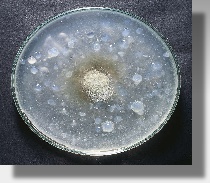Other - Microbiological
CERL, Inc
ENVIRONMENTAL CONSULTANTS
ROCKY MOUNTAIN SPOTTED FEVER
This tickborne rickettsial disease is common in the Rocky Mountains. The most common carrier is the deer tick. While this disease is
rarely fatal, if untreated, it is one to be avoided. Symptoms include high fever and blotchy rash on all areas of the body.
Precautions: check for ticks on an regular basis, use insect repellant around openings in clothing and on exposed skin. If you find a tick
that is imbedded in the skin, never use your fingers for removal, as this will crush the tick and cause intestinal material to be injected into
the wound. They must be removed in such a manner as to avoid crushing.
PSITTACOSIS (parrot fever) & COCCIDIOIDOMYCOSIS
These diseases produce flu like symptoms in humans and are carried by birds.
Psittacosis is specific to parrots and pigeons. The viruses are transmitted to man through the inhalation of dried dropping dust.
Coccidiomycosis is an upper respiratory fungal disease common in the southwest U.S. The disease is transmitted by inhalation of the
fungus or its spores. The organism Coccidioides is commonly found in bird droppings.
Precautions: The PPE and clean up procedures are carried out much the same as for rodent droppings. The droppings should be soaked
with a disinfecting solution before and during clean up. In this instance, iodine or hydrogen peroxide is the best choice as the extremely
high quantities of nitrogen based (ammonia, amino compounds and proteins, etc.) matter in bird droppings makes the use of chlorine
bleach extremely difficult and potentially dangerous from the formation of secondary toxins such as chloramines.
PLAGUE
Plague is endemic in NM and transmitted to man by infected fleas.
Precautions: check for fleas on a regular basis, use insect repellant around openings in clothing and on exposed skin. If you find a flea
that is imbedded in the skin, never use your fingers for removal as this will crush the flea and cause intestinal material to be injected into
the wound. They must be removed in such a manner as to avoid crushing. Seek medical attention.
Avoid picking up dead animals, particularly rock squirrels or prairie dogs, as the fleas on these animals often are infested with
plague-carrying fleas. Similarly, avoid contact with burrows or nest materials of these animals. If you suspect plague is present in an area,
contact environmental health authorities immediately.
MOSQUITO BORNE DISEASES
Both the Western Equine and Saint Louis encephalitis are endemic in New Mexico. The disease is transmitted by the large Culex tarsalis
mosquitoes and normally appears in the early fall.
Malaria was a major problem in New Mexico until the 1930s. This disease has killed many and may still exist in the San Juan River area
and Rio Grande valley from Las Cruces to Soccoro. Due to implementation of extensive mosquito control programs, there have been few
reported cases in the last 20 years, but the potential still exists for those who spend a great deal of time exposed to the Anopheles
mosquitos.
The small Aedes egyptii mosquito exists in the southern New Mexico Rio Grande river area and may be a carrier of Yellow Fever. While
there are few reported cases of Yellow Fever in New Mexico, the presence of the carrier warrants caution.
Precautions include the use of repellents whenever outdoors. Seek medical attention if you experience health changes following receipt
of mosquito bites.
FLY BORNE DISEASES
Flies may carry a wide range of diseases, largely due to their ubiquitous nature. This is particularly the case in areas where there are
unsanitary conditions, such as open garbage dumps, pit privies, and unprotected water, milk and food supplies. Flies are known carriers
of pathogens which cause such diseases as cholera, amebiasis, typhoid fever, paratyphoid fever, and shigellosis (bacillary dysentery). The
primary route of transmission is through contact of flies with the feces of contaminated persons or with materials, water, food or milk
contaminated by the feces of contaminated persons. The reservoir for all of these diseases is man.
Precautions: Do not drink untreated or nonpotable water, nor consume milk or food which has not been protected or stored at
appropriate temperatures. Thoroughly wash hands before eating.


